Does A Road Bike Have Gears? Absolutely, road bikes are equipped with gears to optimize your pedaling efficiency across various terrains, and here at usabikers.net, we’re passionate about helping you understand and master them. Whether you’re climbing steep hills or speeding down descents, gears allow you to maintain a comfortable cadence and maximize your performance. Let’s explore the world of road bike gearing, from different types of setups to electronic shifting, ensuring you’re ready to conquer any road.
1. What Determines the Number of Gears on a Road Bike?
The number of gears on a road bike is determined by multiplying the number of chainrings in the front by the number of sprockets in the rear cassette. For instance, a bike with two chainrings and a 12-speed cassette has 24 gears. Similarly, two chainrings paired with an 11-speed cassette offer 22 gears. A triple chainring with an 8-speed cassette also results in 24 gears. This multiplication determines the total number of gear combinations available to the rider.
1.1 Why Are Gears Necessary on a Road Bike?
Gears are essential on road bikes because they allow riders to maintain a comfortable pedaling speed (cadence) regardless of the terrain. A single gear cannot provide optimal efficiency for both uphill climbs and downhill descents. Gears offer the flexibility to adjust resistance and maintain consistent effort.
1.2 High Gears vs. Low Gears
A high gear, often referred to as a big gear, is best used when descending or riding at high speeds. This is achieved by combining the largest front chainring with the smallest rear sprocket. For example, a 50×11 setup provides a high gear ratio.
Conversely, a low gear is optimal for climbing steep hills. This is achieved by combining the smallest front chainring with the largest rear sprocket. Low gears make it easier to keep the pedals spinning when the road inclines sharply.
1.3 Gears and Speed: Dispelling Myths
Having a large number of gears doesn’t necessarily make a bike faster. The primary purpose of multiple gears is to provide a broader range of options for maintaining efficient pedaling in various conditions. Just as a car needs different gears to accelerate from a standstill or climb a hill, a bicycle benefits from having a range of gears to suit different situations.
1.4 Efficiency and Range
More gears provide greater scope for finding the optimal pedaling speed. In the past, nine-speed cassettes had significant gaps between each gear, which meant less precision in choosing the ideal cadence. Modern 12 and 13-speed cassettes have additional sprockets to close these gaps, offering a smoother and more efficient progression. Smaller gaps between gears improve pedaling efficiency, allowing riders to fine-tune their cadence to suit the terrain and gradient, ultimately reducing energy expenditure.
1.5 Precision and Shifting
Modern multi-speed cassettes also improve shifting precision. Smaller increments between gears reduce the mechanical effort required for the chain to climb onto a larger sprocket or drop down onto a smaller one, resulting in smoother and more reliable shifts.
 Cyclist using bike gears while climbing
Cyclist using bike gears while climbing
1.6 Single-Speed Bikes: An Alternative
While many road bikes have multiple gears, some riders opt for single-speed bikes. These bikes have only one gear, determined by the size of the front chainring and rear cog. Single-speed bikes are popular among commuters in flat areas due to their low maintenance requirements. Some racers, such as hill climbers, also use single-speed bikes to reduce weight and simplify the shifting process. Track bikes also typically have only one gear, with riders adjusting the gear ratio to suit specific events.
1.7 Overlapping Gears and Chain Crossing
On multi-geared bikes, especially those with a high number of gears, some gear combinations may result in overlapping ratios. This means that certain combinations of chainrings and sprockets provide the same overall gear ratio. For example, a 53×19 setup can have the same ratio as a 39×14 setup.
Additionally, using extreme gear combinations can strain the chain, a practice known as crossing the chain. It’s generally advisable to avoid using the largest front chainring with the largest rear sprocket, or the smallest front chainring with the smallest rear sprocket, to prolong the life of the chain and ensure smooth shifting.
2. Different Types of Road Bike Gears and How They Work
The extensive range of gearing options available today allows cyclists of all abilities to get the most from their pedaling. Let’s delve into the different types of bike gears, from traditional setups to modern innovations. Understanding these options can help you determine the best fit for your riding style and needs.
2.1 Standard Double
A standard double setup consists of two chainrings at the front paired with up to 9, 10, 11, or 12 sprockets at the rear. Traditionally, a 53-39t chainring combination was considered standard, but it’s now less common among recreational cyclists and is rarely specified on new bikes.
Despite this shift, standard double setups remain a popular choice for racing. They offer the largest chainring sizes, providing the biggest gears possible for maintaining smooth pedaling at high speeds. The reduction of lower gearing is limited, usually to a 38t inner chainring, making it less suitable for those seeking very low gears.
2.2 Compact
A compact setup is essentially a smaller version of the double chainring system. Both chainrings are reduced in size, typically featuring a 34t or 36t inner ring paired with a 48t or 50t outer ring. This setup reduces the gear ratio across the range, making it a popular choice for riders tackling varied terrain.
The reduction in gearing at the lower end is sufficient for most cyclists to tackle long and steep climbs, especially when paired with a 32t cassette. Crucially, the top gear reduction isn’t significant, allowing for fast descents and maintaining speed on flat terrain.
2.3 Semi-Compact
Semi-compact chainsets have gained popularity in recent years and are now commonly found on race-oriented bikes sold with Shimano or Campagnolo double-ring setups.
This setup combines a 52t outer chainring with a 36t inner ring. This combination offers a balance of both high and low gears. The 36t inner ring can be paired with an 11-28, 11-30, or 11-32 cassette, providing enough gears to tackle almost any climb. The 52t outer ring offers a bigger gear for fast group riding, descending, and even racing.
2.4 Triple
Triple cranksets are less common today but can still be found on hybrid and touring bikes. The benefit of a triple crankset is that it provides a wide gearing range without requiring as many sprockets on the cassette, making it a more affordable and robust option. The small inner rings allow for a smaller bottom gear than typically found on a double crankset. This makes it an excellent choice for loaded touring.
2.5 SRAM AXS
In 2019, SRAM launched its AXS groupset, available in Red eTap, Force, Rival, and Apex versions. This groupset features smaller chainrings, with options including 50/37T, 48/35T, 46/33T, and even a 43/30T in Force and Rival builds (the wide option requires a wide front derailleur).
The 12-speed cassette starts with a 10-tooth sprocket and prioritizes small jumps between the smaller sprockets, balancing this with larger jumps between the bigger sprockets to provide a wide overall range. This design offers small cadence changes when riding hard and fast on flat terrain while providing plenty of lower gears when climbing.
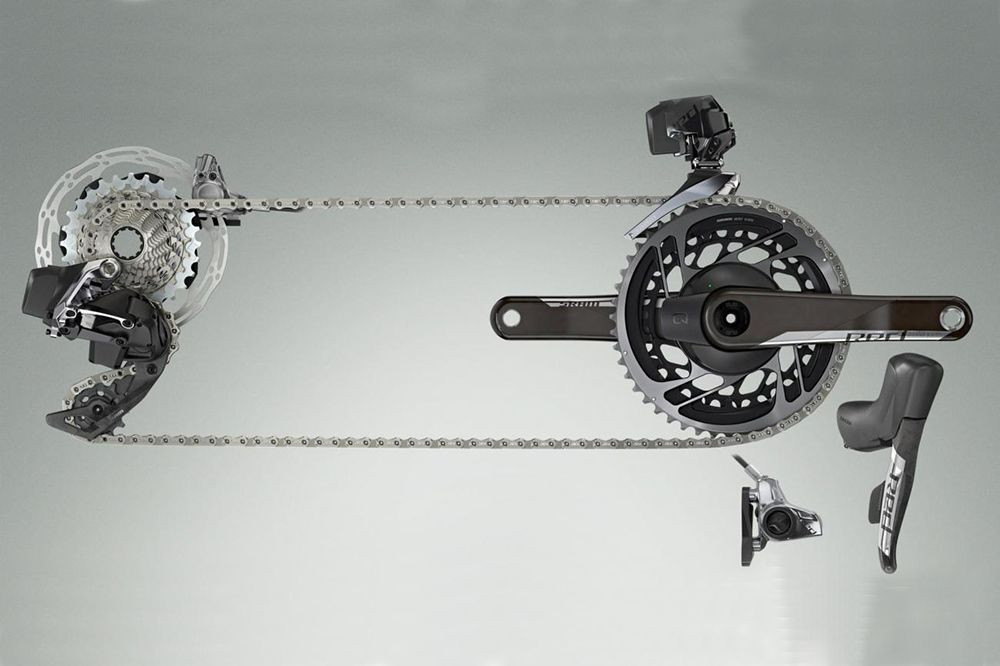 SRAM Red eTap AXS groupset
SRAM Red eTap AXS groupset
2.6 1x or Single Chainring
Single chainring setups were once limited to track bikes and beach cruisers, but they have gained popularity thanks to SRAM, Shimano, and Campagnolo. These setups pair a single chainring with a multi-speed cassette, typically 11, 12, or 13-speed.
Favored for their simplicity, 1x systems eliminate the need for a front derailleur, making gear shifting a straightforward choice of moving up or down the cassette. Special chainrings and rear derailleurs with a clutch mechanism ensure the chain remains in place despite the lack of a front derailleur.
1x setups have become a favorite among gravel riders, where chain retention is crucial and larger gear jumps are less problematic. Shimano’s GRX and Campagnolo’s Ekar groupsets are gravel-specific 1x offerings. SRAM has also updated its Red AXS 1x groupset to 13 gears.
However, 1x groupsets aren’t just for gravel. They can be a great option for criterium races or riding on flat terrain. Some WorldTour teams have experimented with single chainring setups for certain races to maintain an optimal chainline. The simplicity of 1x systems also makes them ideal for cycling beginners.
2.7 Hub Gears
Hub gears are robust, low-maintenance planetary gear systems housed in a fat rear hub. The Rohloff hub, a popular option, has 14 gears. Four, seven, eight, nine, and 12-speed options are available from SRAM, Shimano, and Sturmey-Archer.
While the choice of individual gears may be less than with a derailleur system, it’s still possible to personalize ratios by adjusting chainring and rear sprocket sizes. Hub gears are durable and require minimal maintenance, making them ideal for everyday commuter bikes. They also allow gear changes without pedaling, which is convenient at traffic lights. However, their weight can be a disadvantage in hilly terrain and on endurance rides.
In 2019, Classified, a Belgian tech company, released its Powershift system, a wireless electronic hub system that now boasts 24 gears and instant shifting, even under load. The hub requires a compatible wheelset, and several wheel brands now offer Classified options.
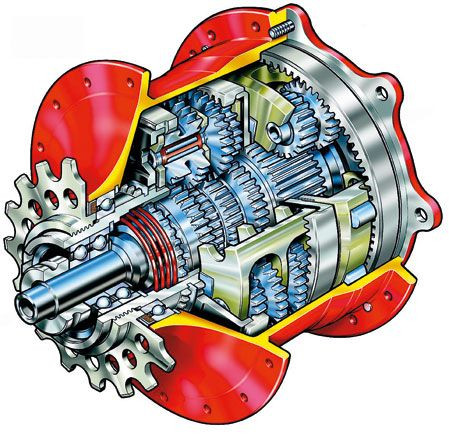 Hub gears on a bicycle
Hub gears on a bicycle
3. How Road Bike Gear Shifters Work
Understanding how to use gear shifters on your road bike is crucial for maximizing efficiency and control. Modern designs can vary, but here’s a breakdown of the basics for most mechanical groupsets on the market. Typically, the right-hand levers control the rear derailleur, while the left-hand levers control the front derailleur.
3.1 Shift Lever Configuration
Regardless of the brand (Shimano, SRAM or Campagnolo), the right-hand levers are responsible for controlling the rear derailleur, which shifts the chain across the cassette sprockets. The left-hand levers operate the front derailleur, which shifts the chain between the chainrings. Electronic gears often work differently, with some systems like SRAM AXS and the latest Shimano Di2 allowing customization to the rider’s preference.
3.2 Campagnolo Shifters
Campagnolo road bike gear shifters typically include a lever behind the brake lever and a thumb button on the inside of the shifter hood. The lever behind the brake lever is used to shift the chain up the cassette into an easier gear, while the thumb button shifts the chain into a harder gear.
3.3 SRAM Shifters
SRAM road bike gear shifters generally use a single lever behind the brake lever to shift both up and down the cassette. A short tap of the lever shifts to an easier gear, while a longer push shifts to a harder gear. Some SRAM systems, like eTap AXS, use a different configuration with two buttons – one for shifting to easier gears and one for shifting to harder gears.
3.4 Shimano Shifters
Shimano road bike gear shifters feature two levers behind the brake lever. The smaller lever shifts to an easier gear, moving the chain up the cassette, while the larger lever shifts to a harder gear, moving the chain down the cassette.
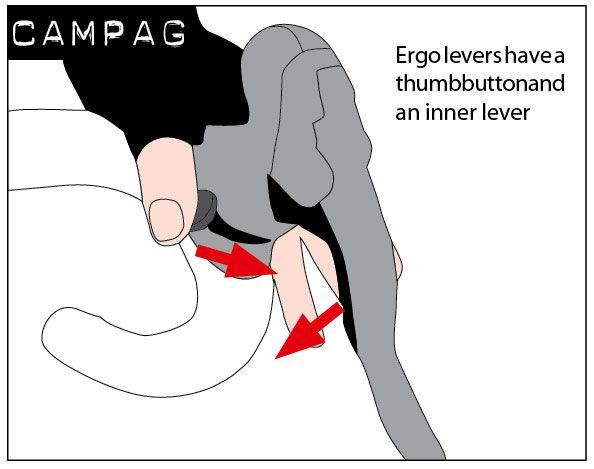 Diagram of Campagnolo road bike gear shifters
Diagram of Campagnolo road bike gear shifters
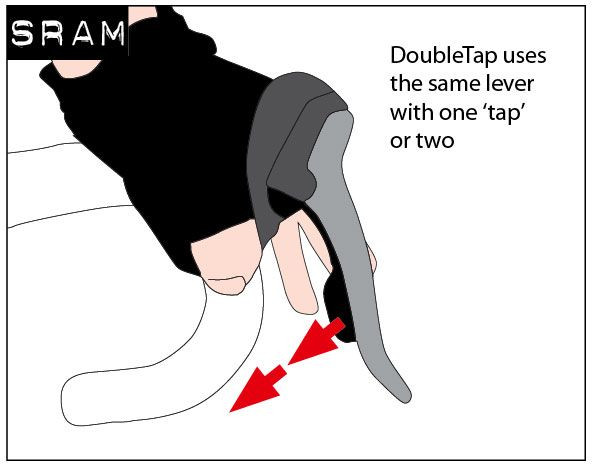 Diagram of SRAM road bike gear shifters
Diagram of SRAM road bike gear shifters
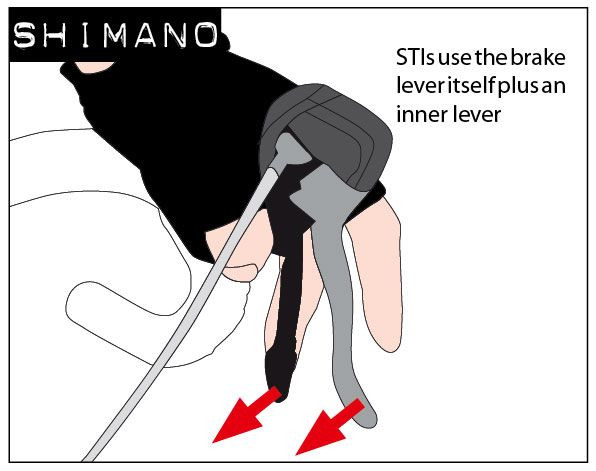 Diagram of Shimano road bike gear shifters
Diagram of Shimano road bike gear shifters
4. How Electric Road Bike Gear Shifting Works
Electric gear shifting systems offer precise and effortless gear changes with the push of a button. Here’s a breakdown of how electronic shifting works for Shimano, Campagnolo, and SRAM.
4.1 Shimano Di2
Shimano’s electronic Di2 groupsets, including Dura-Ace, Ultegra, and 105, use a button system that mirrors the principles of mechanical shifters. The left shifter operates the front derailleur, while the right shifter operates the rear derailleur.
Each shifter has two buttons behind the brake lever. On the left, the slimmer, dimpled inner button shifts the chain from the small ring to the big ring. The smooth, paddle-shaped outer button below moves the chain down from the big ring to the small ring. On the right shifter, the inner, dimpled button moves the chain up the cassette to easier gears, while the smooth outer button moves the chain toward harder gears.
 Shimano Dura Ace shifter
Shimano Dura Ace shifter
4.2 Campagnolo Super Record EPS
Campagnolo Super Record EPS shifters feature a button behind the brake lever and a thumb button inside the shifter hood, similar to their mechanical counterparts. On the right-hand shifter, the button behind the brake lever moves the chain up the cassette to an easier gear, while the thumb button moves the chain to a harder gear. The EPS system also offers multi-shift, allowing the chain to shift multiple gears when the button is held down.
On the left-hand shifter, the paddle button behind the lever moves the chain from the inner small ring to the larger outer ring, while the left-hand thumb button does the opposite.
Campagnolo has also introduced Super Record WRL, a wireless groupset that eliminates the thumb buttons in favor of buttons more in line with Shimano and SRAM.
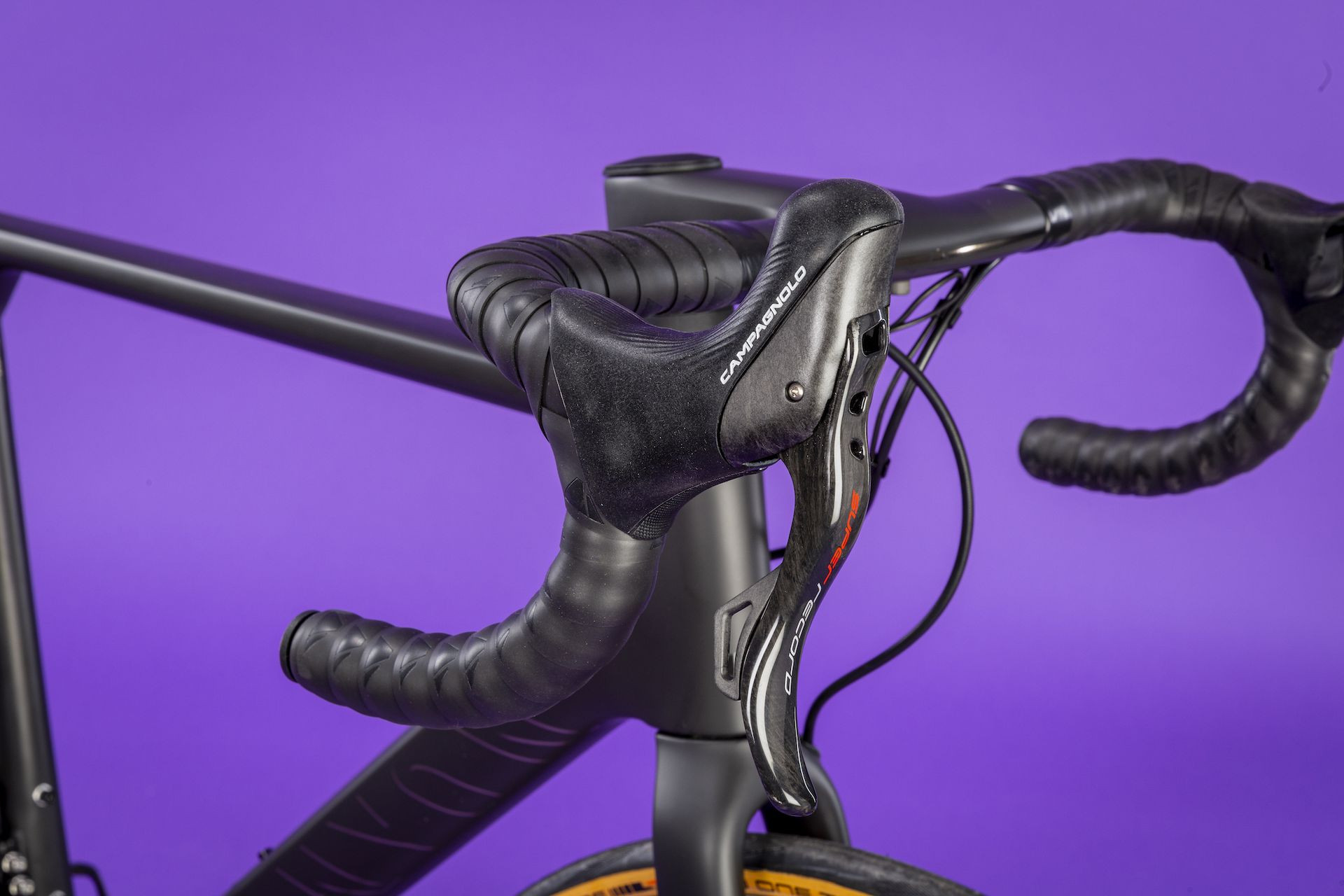 Campagnolo Super Record EPS shifter
Campagnolo Super Record EPS shifter
4.3 SRAM AXS
SRAM eTap AXS groupsets, including Red, Force, Rival, and Apex, operate differently from mechanical SRAM groupsets and other electronic groupsets. SRAM AXS shifting is customizable, but the default setting uses just two buttons.
The right-hand paddle button, behind the brake lever, moves the chain to a harder gear on the cassette. The left-hand paddle button moves the chain up the cassette to an easier gear. To move the chain between the two front chainrings, the rider simply needs to push both the left-hand and right-hand buttons simultaneously, and the chain will move up or down depending on its starting position.
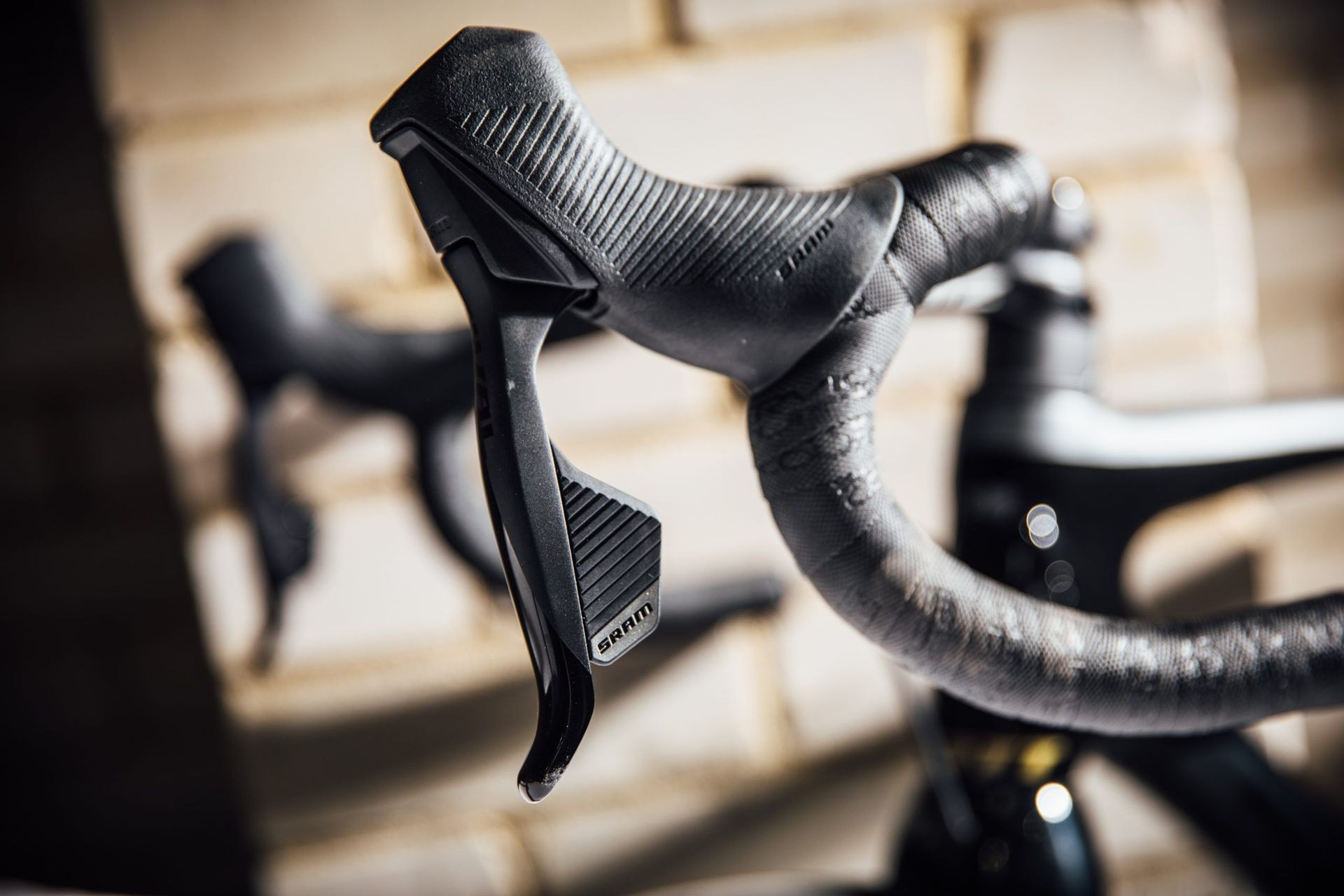 SRAM Rival eTap AXS shifter
SRAM Rival eTap AXS shifter
5. Road Bike Gearing Glossary
To better understand how gears on a bike work, here’s a glossary of key terms:
| Term | Definition |
|---|---|
| Chainring | Toothed ring at the front end of the drivetrain, attached to the crank. |
| Cassette | Cluster of sprockets at the rear of the drivetrain, containing multiple gears of various sizes. |
| Block | Another term for the group of rear sprockets, but typically refers to older, screw-on freewheels. |
| Derailleurs | Front and rear derailleurs move the chain from one sprocket or chainring to the next. |
| Sprocket | Refers to an individual gear within the cassette/block. |
| Ratio | Describes the relationship between sprockets and chainrings (e.g., 53×12) or the sprockets on a cassette. |
| t | Short for teeth, describing how many a given sprocket has (e.g., 23t). |
| Drivetrain | All moving parts connecting the crank to the rear wheel, including the chain, cassette, and chainrings. |
| Cadence | Pedaling speed, measured in revolutions per minute (RPM). |
| STI Lever | Shimano Total Integration lever, combining brake and shift levers for road bikes. |
| Ergo Lever | Campagnolo’s version of integrated gear shift and brake levers. |
| DoubleTap Lever | SRAM’s shifter technology, using the same lever for upshifts and downshifts. |
6. FAQ: Road Bike Gearing
| Question | Answer |
|---|---|
| Do road bikes have gears? | Yes, road bikes have gears to help riders maintain a comfortable pedaling speed on different terrains. |
| How do I shift gears on a road bike? | Use the shifters on the handlebars. Right-hand shifters control the rear gears, and left-hand shifters control the front gears. |
| What is the purpose of gears on a bike? | Gears allow you to maintain an efficient pedaling cadence regardless of the terrain, whether climbing steep hills or riding fast on flat roads. |
| What’s the difference between high and low gears? | High gears are for high speeds and downhill riding, while low gears are for climbing hills. |
| What is a compact chainset? | A compact chainset has smaller chainrings (e.g., 50/34) for easier climbing. |
| What is a standard chainset? | A standard chainset has larger chainrings (e.g., 53/39) for higher speeds on flat roads and descents. |
| What is a cassette? | The cassette is the cluster of sprockets on the rear wheel. |
| What does 1x mean on a road bike? | 1x means the bike has a single chainring in the front, simplifying gear changes. |
| How many gears should a road bike have? | The number of gears depends on the type of riding you do, but most modern road bikes have between 11 and 24 gears. |
| What is electronic shifting? | Electronic shifting uses electronic derailleurs for precise and effortless gear changes. |
Understanding road bike gearing can significantly enhance your riding experience. Whether you’re a beginner or an experienced cyclist, mastering your gears will allow you to tackle any terrain with confidence. At usabikers.net, we provide the information and resources you need to get the most out of your cycling adventures.
7. Discover More at usabikers.net
Ready to take your cycling knowledge and experience to the next level? Visit usabikers.net to explore a wealth of articles, reviews, and guides tailored for motorcycle enthusiasts and bikers. Discover in-depth information about various motorcycle models, essential accessories, safe riding techniques, and upcoming biker events across the USA.
7.1 Connect with the Biker Community
Join our vibrant community of bikers to share your experiences, ask questions, and connect with fellow riders. Whether you’re a newbie seeking advice or a seasoned biker with valuable insights, our platform offers the perfect space to engage and grow within the biking culture.
7.2 Stay Updated with the Latest Trends and News
Keep up-to-date with the latest trends, news, and regulations in the motorcycle world. Our team at usabikers.net is committed to providing you with timely and accurate information to ensure you’re always in the know.
7.3 Contact Us
Have questions or need assistance? Reach out to us through the following contact information:
- Address: 801 Sturgis Main St, Sturgis, SD 57785, United States
- Phone: +1 (605) 347-2000
- Website: usabikers.net
Don’t miss out on the opportunity to elevate your biking journey. Visit usabikers.net today and immerse yourself in the world of motorcycles and biker culture. Explore our articles, join our forums, and gear up for your next adventure!
